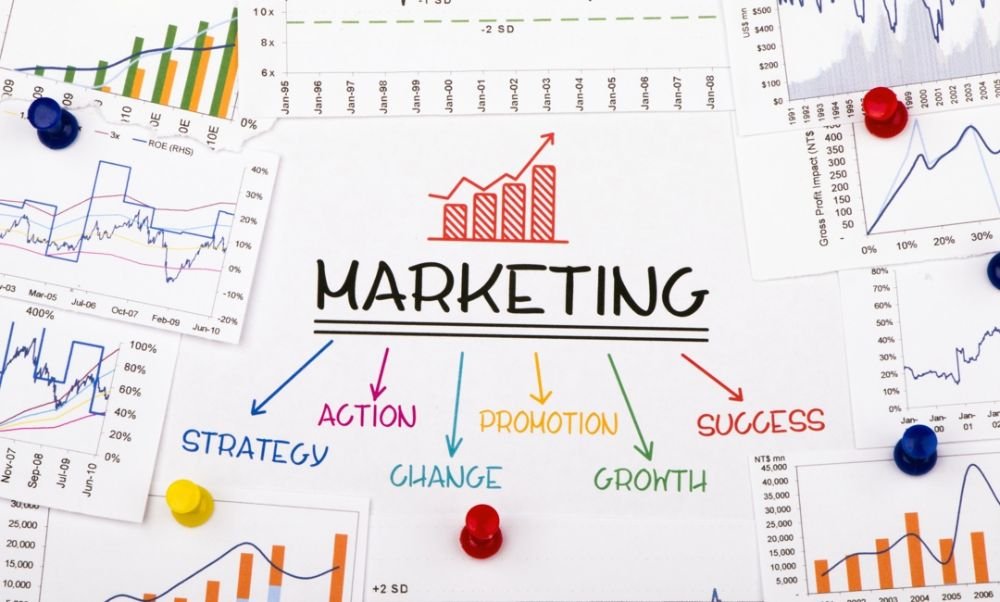Marketing keeps businesses in business. It drives sales, enables growth, and builds an organization’s reputation and community. But the best marketing tactics benefit your customer as much as it does your bottom line.
That’s why digital marketing basics revolve around communication. The first goal is to find customers and to help them find you. Then the objective is to form relationships and maintain them over the long term.
Think about digital marketing as a three-step process through which you want to take potential customers:
- Awareness. You have high-quality products or services to offer. Let people know about them and your business. Become a possible resource for customers.
- Connection. Stay in their lives and their minds. Become a part of their network and make them a part of yours.
- Support. Keep them happy by continuing to offer help, encouragement, and community. Become their partner in the projects that matter to them and make them a partner in your continued success.
When done well, these steps should overlap and even repeat themselves. For instance, old relationships can fade into the background, requiring you to reignite a customer’s awareness.
The fundamental importance of small business marketing may not be hard to grasp. But, there are several factors that play a role in local business marketing as well as a potentially overwhelming amount of options.
This article on digital marketing basics will break down major aspects of digital marketing, give you a sense of where to focus your attention and resources, and help you create a marketing strategy.
Traditional vs. Online Marketing
What’s the difference? Digital marketing or online marketing takes place online, through digital channels. It includes your websites, online listings, emails, and social media accounts as well as paid online advertisements. This category also contains everything you do to support your reputation online such as review management and content that you publish on other websites.
Traditional marketing takes place offline. It includes older forms of media such as print, television, and radio. It also includes forms of direct communication such as snail mail, promotional products, and telemarketing. Mobile, text-based communication, however, has started to blur the line between traditional and digital phone marketing.
Digital marketing offers certain advantages that traditional marketing can’t. It’s often cheaper and easier both to track and to tweak to measure and increase success.
Which Is Right For You?
Probably both.
Most businesses combine the two. Even eCommerce companies often use branded packaging or include something like a flyer or a sticker with invoices. And local businesses often benefit from distributing printed promotions around the neighborhood.
In other words, the “vs.” in “traditional vs. online marketing” is just a matter of definition. Develop your digital marketing strategy and tools, but don’t wholly neglect old-school marketing techniques. And you should never stop doing something that’s working for you already.
Branding
In some ways, branding is the most fundamental of marketing basics. It’s so ingrained that it almost doesn’t seem like marketing at all.
Branding is also one of the hardest concepts to pin down. It combines both traditional and online marketing with the very identity of your business – your personality, practices, location, image, and name.
Your brand encompasses all the ways that you represent your business and all of the things that people associate with it.
Think of Charmin toilet paper. Any of the following words or images might pop into your mind:
- Blue
- Primary colors
- Animated bears
- “Enjoy the go!”
- Soft
- Baby bottoms
- A cloud
- Extra-large rolls
- The company’s custom font
All of the above are a part of the company’s brand. In addition, there’s a sweet silliness that characterizes it.
Almost a hundred years ago, Charmin got its name from an employee’s description of the toilet paper as “charming.” Since then, it’s changed the way it interprets the word multiple times, but charm has remained at the heart of its brand identity.

Charmin’s consistent use of the same images, colors, and fonts are all part of its branding. So are the style of its advertisements and the personality of its cartoon bear mascots.
How to Build Your Brand
First, you’ll need to define your brand. Identify a few keywords that describe your brand and how you want others to view it. If stuck, you can ask current customers for input or use a word bank of potential adjectives. Outline your target audience as well since it will contribute to your communication strategy.
Once you have your core characteristics in place, you can start to flesh it out. Develop aspects of your identity, then create a set of brand guidelines to which you can refer and that you can share with employees and potential partners.
Vision and Values
What’s the history of your business? What’s your mission statement? Do you have a slogan that sums up the attitude you bring to day-to-day operations or the philosophy you want to inspire in others?
Define who you are, the values you uphold, and the greater story that your business seeks to live and to tell others. Customers should know what they can expect from you at every level.
Make sure that every message about or from your business fits into this greater narrative. Branding revolves around consistency. When it comes to vision and values, consistency is inseparable from integrity. Guidelines in this area help a business stay true to itself no matter what challenges arise.
Visuals and Voice
There are multiple ways that a person might come into contact with your business. They might come to your website or your physical location. They might see a flyer or read an article written by an employee.
This set of “v’s” covers the look and sound of your business.
You want to establish a uniform – or at least a harmonious – style. Each brand element should coordinate with the next and be internally consistent. Consider the following:
- Physical premises
- Logo
- Colors
- Fashion/artistic sensibility
- Web design
- Expression/phrasing/language
- Tone of voice
- Level of sophistication
- Conventions for capitalization, citation, spelling, and grammar
- Create a coherent design and a persona that is so well defined that anyone in your business can assume it.
Search Engine Optimization (SEO)
Search engine optimization (SEO) refers to the actions that you can take to improve your ranking in organic search results. In other words, it’s the art of appearing on the first page of Google when people search for your business or for the services you offer.
The higher your ranking, the more likely that people are to click on the link taking them to your website or an online listing. In fact, there’s an old joke: the best place to hide a dead body is page two of Google.
So what makes Google rank one website higher than another? It wants to give searchers results that are relevant, popular, and high quality.
The location also matters. If Google determines that a search has “local intent” – that someone wants to find a nearby business – its results change in two important ways. The first is that it ranks closer businesses more highly. The second is that instead of business websites, it places a map with several Google listings at the top of the page.

When I searched for “best restaurants near me” on Google, the algorithm decided that my search had local intent. Its results start with a map of neighboring eateries.
Local search engine optimization is a large topic – which is why we’ve provided an entire article on it. But here are a couple of search engine marketing basics.
Optimize Your Website
Your website is your online front door. You want to make it both attractive and easy to find. Its design should incorporate SEO principles from the very beginning. To that end:
Don’t neglect technical SEO. For example, make sure that your site is quick to load, secure, and doesn’t have any broken links.
Underscore your location. Put basic business information into a header or footer that appears on every page. Embed a Google map or provide directions. Reference your town or neighborhood frequently in web copy.
Integrate keywords. Demonstrate your relevance to certain searches by incorporating those phrases into your web copy.
Build backlinks. Get other websites to link to your site. Local news outlets and nearby businesses are good potential sources, but keep an eye out for opportunities to sponsor local events or be listed in local directories.
Claim Your Listings
Because local searches prioritize location, your Google Business Profile is essential. Fill it out with all the relevant information and link to your own website. Doing so will also help you manage your reviews (see below). Google reviews have become one of the first places people look when researching local options.
Claim other listings, too. While Google may be the most important, you can claim your listings on Facebook, other review sites, and various directories. This gives you control, allowing you to make sure that information is current. You can also respond to reviews and often add pictures or other content.
Content Marketing
Content marketing is a huge field. After all, the word “content” is even broader than the word “branding.” It can include traditional marketing material such as a physical leaflet. However, when people talk about content marketing, most often they mean a form of internet marketing.
In the digital sphere, content marketing covers any kind of content made to be distributed online. Some examples are:
- Blogs
- Social media posts
- Infographics
- Podcasts
- Articles
- Videos
- Whitepapers or ebooks
- Free apps or other tools
- Website pages
- Online presentations or courses
Businesses create this material and offer it for free. By continually generating valuable content, you can move customers through the stages of a marketing relationship: make them aware of you, develop a connection, and become a source of support.
While some of this content is openly available to all, you can also focus content on those who actively want it. Offer subscribers a newsletter filled with tips and tricks related to your services. Or use an industry ebook as a lead magnet, sending it to people who submit their email addresses.
Content marketers work with multiple channels as well. They maintain email lists and generate proprietary web content for owned sites. They publish videos through YouTube channels or podcasts through hosting services. They post articles on business blogs or LinkedIn. They use social media accounts to broadcast short messages.
There’s a dizzying array of possibilities, but note that they are possibilities – not requirements. As a local business, your content strategy should focus on a couple of channels. Don’t spread yourself too thin. You can always experiment and expand later. It’s better to regularly publish high-value content on one channel than to occasionally post things here and there.
As you develop your plan for content marketing, there are a few digital marketing basics to keep in mind.
Blog and Webpage Content
When you generate new material for your blog or website, you accomplish two things. First, you expand the resource library available to new and returning clients. For instance, you might create a video introducing your team or write a post that answers a common question associated with your area of expertise.
Second, you improve the odds that Google will send customers your way. A blog is a great way to incorporate industry keywords into your site.
Email Marketing
As a small business, one of your greatest assets is a strong email list. Email marketing has the highest return on investment of any marketing channel, and the competition isn’t close. Small businesses get an average of $42 for every dollar they spend.
You can use your email lists to advertise promotions, welcome new customers, reengage old ones, or distribute a newsletter. Email services also help you to follow up with customers after a purchase.
Use automation to deepen customer relationships and add a personal touch. It would be hard – if not impossible – for you to memorize every client’s birthday. But you can program an email service to send birthday wishes or to let customers know when specific products go on sale.
Social Media Marketing (Free)
Social media marketing is one area where it’s really easy to go overboard. There are so many social platforms, but you should focus your efforts on one or two. Use this platform to connect with your customers regularly, by posting your own content and engaging with the questions or comments of others.
Whether it’s your primary channel or not, you should have a Facebook business page. Facebook operates as an important source of local listings and reviews as well as a place to post your own content. Some people use it to look up basic business information, so keep it up to date.
Digital Advertising
Another form of social media marketing is paid digital advertising. You can target either possible searches – skipping the SEO line – or customers that fit certain demographics or have demonstrated interest in your products.
Google Ads
There are two types of Google ads. The first looks almost exactly like organic search results but includes a small “Ad” designation.
This example from Google’s own support page shows the small “Ad” designation that accompanies search ads.
Google allows you to bid for these ads, paying either each time a browser clicks on them or per thousand impressions. Different keywords are more or less expensive depending on how competitive they are.
Google’s keyword planner will also suggest related keywords, some of which may be less expensive. It’s a great tool to use when planning your content marketing as well as your digital advertising.
The other kind of Google ad is a display ad. Instead of showing up in search results, Google places these on other websites depending on either the website’s content or the viewer’s search history. They’re like hyperlinked billboards or posters.
Social Media Marketing (Paid)
In addition to Google ads, you might also invest in social media advertising. Facebook and Instagram ads target your imagined ideal customer rather than a search. They then show up in those viewers’ feeds.
Social media platforms also distinguish between ads and organic posts, but they can still be very effective. There are 2.91 billion Facebook users across the globe, and Facebook allows you to refine your audience based on their location.
Customer Retention
Local businesses rely on loyal customer bases, and marketing basics focus on customer retention as well as the attraction of new clients. Besides, the two go together. Happy customers become your business’s advocates. Unhappy customers can become obstacles.
Review Management
These days, almost 90% of people consult online reviews. People look to them for advice on where to eat, what to buy, and which businesses to use. And while people don’t believe everything that they read, they do tend to give them some credit – particularly when trends emerge. Review management is an important part of digital marketing.
There are three challenges in review management:
How to Get Reviews
Reviews are one area where quantity matters as much as quality. On most sites, people instantly see two numbers associated with a business’s reviews – the average rating and the number of ratings.
You want both of these numbers to be high. Customers are more inclined to give your business a try if you have a long, proven history of customer satisfaction.
In this set of local listings for Detroit auto stores, you can see the ratings just below the business names. The average rating comes before the stars, and the number of ratings comes after.
The number one thing you can do to get more reviews? Ask for them. Put up a small sign in physical locations directing customers to your review site of choice. Include a request in follow-up emails.
Above all, deliver exceptional service that makes people want to honor that request.

How to Respond to Reviews
Your customers are speaking; you should listen and respond. Even positive reviews require a response. People took some of their valuable time to endorse your business. Thank them.
You need a way to keep track of reviews, no matter where they’re posted. Review management tools collect reviews from across the web and allow you to respond from a central hub.
Encourage people to use the site of your choice – such as Google, Yelp, or Facebook – but be prepared for them to leave them elsewhere. There are a huge number of review sites, and people will have their own favorites.
When it comes to negative reviews, stay positive, polite, and professional. Reach out to the dissatisfied customer, but try to take the conversation offline and handle the issue directly.
How to Use Reviews
If a customer has a complaint, address it in your business practices rather than just in your text. Reviews are free sources of feedback about ways that you can improve.
Moreover, nothing turns an unhappy customer into a happy one faster than seeing their concerns addressed. You might even invite them to return to see how you’ve handled the issue. Many customers are also willing to write follow-ups to negative reviews, crediting the business for fixing an issue.
Loyalty and Referral Programs
You may already have a loyalty program such as a punch card or discounts for repeat customers. Integrating these programs into your digital marketing will make them easier to use and manage.
Use your email lists and websites to run referral campaigns, too. You can build related questions into online intake forms, allowing new leads or customers to tell you who turned them on to your services.
Social media platforms such as Instagram offer a new kind of referral: the branded hashtag. For example, a salon might offer customers who showcase their new style online and tag the business a coupon. Give them a 10% discount on their next cut so long as it takes place within three months. It’s a great way to turn customers into influencers.
Your Best Marketing Strategy
Sometimes it seems as though small business marketing requires advanced degrees in statistics, design, engineering, and diplomacy. But the right tools help level the playing field. You don’t need to know how to program something like Google’s keyword planner to use it.
If you want to make the most of your potential, you might also consider the right partner. In addition to the best technology around, Scorpion also offers custom strategies tailored to the needs of your local business. Schedule your free consultation, and let’s discuss how we can achieve your most ambitious goals.
Save your focus for the things that you do better than anyone else. Our team of experts will take care of the rest.
We will set you up with a great website, content, and advertising to get more customers to grow your business. Get started with Scorpion.



